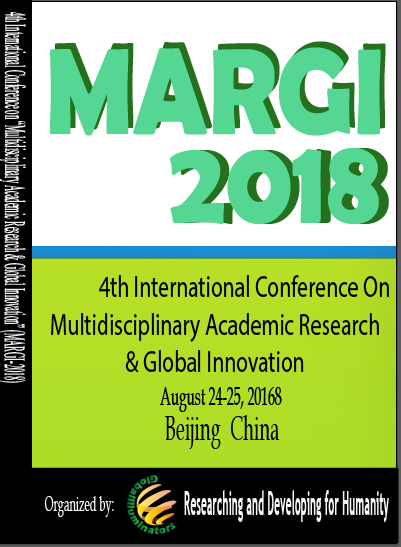
Preface of proceeding
Track: Social Science & Humanities
What Factors Contribute to Higher Incomes Among Educated Workers in Asia?
Pages 1-13
Mamiko Takeuchi
Abstract
This paper comparatively analyzes the determinants of income and gender gap among higher-educated workers in the principal cities of seven Asian countries, using a survey conducted by a Japanese think tank in 2012. In particular, the effects of added abilities or qualifications are focused upon, such as postgraduate degrees, degrees in their fields, and work or study experience in foreign countries. Results of our analysis show that some additional abilities might be important to earn higher incomes, in varying degrees, according to gender and the country under consideration. Notably, postgraduate degrees earned by Chinese workers and overseas education attained by South Korean workers contributed more toward earning higher incomes for both males and females. In Thailand, both postgraduate degrees and overseas education contributed to earning higher income among female workers. Furthermore, a decomposition analysis of income differentials revealed that no gender gap existed among highly educated workers in India. However, endowment effects could in part be generating gender gaps in South Korea and Vietnam, while coefficient effects contribute to such gaps in China, Indonesia, Malaysia, and Thailand.
Diaster, Relocation and the Social Resilience:The Recovery and Adaptation of Karamumudisane in Changzhi Lily Community after Typhoon Morakot, Taiwan
Pages 14-21
Sasala Taiban, Hui-Nien Lin, Deborah Chun-Hwa Chang, Dau-Jye Lu, Chun-Chieh Ko, Ya-Hsuan Ko
Abstract
After Typhoon Morakot struck Taiwan in 2009, the government ordered the villagers of Adiri, Karamumudisane, Kinulane, and Ira to move to submontane permanent housing in Lily Tribe Community. Because these villagers were accustomed to living in mountainous areas, they encountered challenges in the process of adapting the changes in their lifestyles, traditional means of production, and cultures. Determining whether affected indigenous communities can recover from typhoon-related damage and continue passing down their cultures is crucial. In this study, in-depth interviews and participant observation were conducted and the literature on Karamumudisane was reviewed to examine the impacts of the government-ordered community migration on the land, culture, rituals, and livelihood of the villagers. Furthermore, this study analyzed how social vulnerability was disregarded, oversimplified, and concealed by the government and postdisaster reconstruction organizations. Moreover, this study investigated how the Karamumudisane people organized, mobilized, and united with one another to reconstruct their way of life. This study noted that the cultivation of red quinoa reunited the Karamumudisane people. Additionally, through the establishment of the Academy of Special Rukai Crops, the villagers rediscovered the cultural value of traditional crops. The case of Karamumudisane may serve as an example of post disaster recovery and adaptation as well as the positive effects of social resilience on post disaster reconstruction.
Hoteliers’ Perspective on the Success Factors of Shariah Compliant Hotel Operation Implementation
Pages 22-27
Noor Azimin Zainol, Rozila Ahmad, Muhamad Shah Kamal Ideris
Abstract
Shariah compliant concept has received a special interest in various operations nowadays as people are more aware of the niche market that Islamic tourism has brought forward. This paper seeks to examine the practice of shariah compliant concept by examining the success factors that supports the implementation of shariah practices in hotel operations. Qualitative stance was applied and based on the emerging themes, the success factors contributing to shariah compliant operations were identified as “provision of Muslims’ basic needs”, “demand and support from various sectors” and “fulfilling shariah compliant operational issues”. It was found that awareness on the definition of shariah compliance is a critical factor in implementing this concept hence instilling awareness on shariah compliance concept is crucial so that misconceptions are minimized.
Determinants of Academic Achievement in Japanese University Students: Gender, Attitude to Learning and Choice of University
Pages 28-47
Mamiko Takeuchi
Abstract
In this study, we analyzed the determinants of academic achievement in Japanese university students. Using a survey conducted in 2008, we found that female students had significantly higher academic achievement levels than their male counterparts, in line with previous studies. This result was partly explained by gender differences in attitude to learning at university. We also found that attitudes towards learning held during high school continued at university, and affected academic achievement. Enrollment in the student‟s preferred university increased achievement, but choosing a university made as a result of recommendations from others about courses or place of study, or because of the type of entrance examinations lowered academic achievement. Larger parental incomes and earning more from part time jobs also had potential to lower academic achievement. Subgroup estimations, such as for national universities, private universities, and different faculties, confirmed that the results were robust. In the quantile regression model, the effect of gender decreased with increasing quantiles, but remained significant.
The Difference of the Attitude towards Money among Adult Mongolians
Pages 48-55
Tumendemberel Purev
Abstract
The study presents the attitude towards money among adult Mongolians. The research focused on differences of the attitude towards money related to age, gender and employment in Mongolian people. The aim of this study was to examine the differentiation of the attitude towards money of adult Mongolians related to satisfaction with life, sense of security and the role of socio-demographical parameters such as: age, gender and employment. People‟s attitudes towards money seem to be acquired through education, professional experience, and monetary habits. People perceived money as a symbol of a sense of security, a marker of achievement or status, and the source of worry or anxiety. Researchers noted that money has a multidimensional psychological meaning. The research sample consisted of Mongolian people: a group of 300 Mongolians. The age of participants varied from 21 to 60 years old. Statistical version 10.0 was used to analyze the data.The results showed that the attitude towards money depends on the satisfaction with life, sense of security and was different by gender and employment. Mongolians have strong tendencies to use money as a symbol of power and status. However, this tendency is stronger in the group of men in comparison to women, in this culture. Retention-Time was bigger differentiated by variable employment. It means that Mongolian people who have work perceived money as a means which give them security in the future more than unemployed people. According to the results, there was no significant difference in age. Furthermore, there were negative association between satisfaction with life and distrust in the group. They who have financial worry seem to be less satisfied with their life. The most number of people in Mongolian sample evaluated own income as average. The percentages of personal professional activity were the highest than another categories in the group. The results of statistical analysis showed that differences of frequencies of some components of economic security were significant in the sample. In sum, our study will contribute to knowledge about the importance of general life satisfaction and feeling security on the attitude toward money. The results may be useful to create the program of economic education and program that will change attitude toward money. The results provide information about the cultural difference. The knowledge may be useful for better understanding other nations and integrating people from different cultures.
Perceptions and Preferences of Muslim Domestic Tourists in Indonesia as a Halal Tourism Destination (A Case Study: Halal Tourism in West Java)
Pages 56-63
Damara Saputra Siregar
Abstract
Number of Muslims who travell in the world is growing up year by year. As a country with the largest Muslim population in the world, Indonesia has chance to use the trend as an opportunity to increase the number of tourists in the country. Tourism ministry of Indonesia has set 10 major tourist halal destinations and one of them is West Java. This paper aims to explore the implementation of halal tourism development through the perceptions and preferences of tourists on halal tourism in West Java. The type of research is descriptive with quantitative approach. Data collection techniques in this paper is randomly distributing questionnaires to 100 respondents (tourists). Dimensions assessment of perceptions and preferences of respondents to halal tourism in West Java is adopted from indicators put forward by Global Muslim Traveler Index 2016 with Likert scale. Then, calculate the value of quality and averages, analyzed by gap analysis and quadrant analysis. Based on the results the study found the gap analysis which shows that, there is still gap on all variables between the perceptions and preferences of tourists to halal tourism in West Java. While the quadrant analysis results show that there are some variables that have low performance where as the level of influence is high, some variables with high level of influence followed by good performance, some variables that have low level of influence and the performance is not good and the variable that the influence level is low but its performance is good.
Films, Floods and First Nations: Participatory Video Research of Three Films Regarding Displacement with Indigenous People from Little Saskatchewan First Nation and Lake St. Martin First Nation
Pages 64-70
Shirley Thompson
Abstract
To analyze the participatory video (PV) process of three films, for engaging flood-impacted communities in each phase of filmmaking, as well as measuring the films‟ knowledge mobilization. Three PV films were analyzed for process and product outcomes considering 12 indicators measuring the participation of community members in each aspect of the film process and six indicators regarding the film‟s outreach and impact. The impacts on Indigenous community members from two First Nations over the seven years of displacement due to flooding were documented through three short roughly 20 to 30 minute videos. Each of these films had eight to twelve people sharing stories of how the flood and displacement impacted them. Interviews with vulnerable elders and youth provided visible evidence of suffering to the public and policy-makers that resulted from the province‟s diversion of water to displace First Nation communities. Community members participated by assisting with the filming, scriptwriting, narrating, editing, but held back from engaging in the technical aspects of filming and editing. The films effectively communicated the issues and had thousands of downloads versus a few hundred for papers on the same topic and gained a wide audience through being shown at film festivals, meetings, conferences and community workshops. YouTube films were published at least a year in advance of academic papers despite having the same interview material to work with. For knowledge mobilization of research, the non-traditional route of PV appears more effective than that of journal papers. Films can be published more quickly than peer-reviewed papers, and have a larger reach, providing more currency to shape policy. Recommendations for future research: More research on the impact of academic research videos should be undertaken to determine how to effectively mobilize academic knowledge for different audiences and subject areas..

